

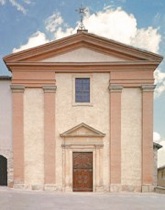
In 1250 (and thus before the formal approval of the Augustinian Rule in 1256) Pope Innocent IV granted indulgences to those who contributed towards the construction of a hermitage here that was planned by seven hermits from Brettino (near Fano). They received a donation of property on the present site in the following year. Other donations followed and , in 1258, Pope Alexander IV allowed what were by then “i frati di Sant’ Agostino di Gubbio” to benefit from fines extracted from miscreants.
The church was documented for the first time in 1271, and a Bull issued by Pope Nicholas IV in 1292 suggests that both the church and the convent were complete by that time. In 1302, Cardinal Napoleone Orsini warned the bishop of Gubbio that the building of the nearby city walls should not compromise the complex.
The friars of Sant’ Agostino acquired the nearby church of Santa Maria Nuova in 1439.
The community was suppressed for two years from 1798 and again, more permanently, in 1869. However, part of the complex was restored to the Augustinians in 1901, including the church, which they restored.
Exterior
The right side of the church, with its cylindrical buttresses, is particularly well preserved. The original facade remained incomplete in 1731. The present brick facade was built in 1790 and the church was re-roofed in 1901.
[Permanent crib in the convent.]
The building to the left of the facade was documented on six occasions in the period 1297-1427 as the “Hospitalis Monasteri Sant’ Agostino”. [Arms of the Confraternita dei Disciplinati del Crocifisso di Sant’ Agostino on its facade?]
Interior
The interior is in the form of an arched nave and a rectangular apse. Eight side chapels were built in the nave in the 15th and 16th centuries and the eight transverse arches of the nave were reinforced in the 1560s. The original frescoes on the sidewalls were destroyed at this time, but those on the walls and vaulting of the apse and on the chancel arch (see below) survive.
The organ (1823) in the 1st chapel on the left is the work of Angelo Morettini, as recorded by an inscription “Morettini Perusini MDCCCXXIII”.
Relics
The church preserved the relics of two of its friars:
-
✴The cult of the Blessed Pietro da Gubbio (Pietro Ghigenzi) died 1287) was recognised by Pope Pius IX in 1874. Unfortunately his relics were destroyed in a fire on 1957. His effigy (1992) is displayed in a glass case in the 7th chapel on the right.
-
✴The cult of the Blessed Francesco da Gubbio (14th century) has not received papal recognition. His relics are preserved in a gilded wooden urn on the altar of the 5th chapel on the left.
Presbytery
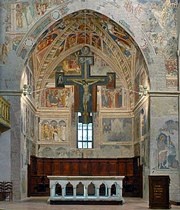

The high altar (ca. 1300) comprises a large mensa supported by 20 columns set into an equally barge stone base. Only the columns on the smaller sides are original: the others were replaced in ca. 1920. At this time, the tabernacle and large wooden screen were removed from the altar so that the frescoes in the apse could be more easily seen. (They are preserved in Santa Maria Nuova- see below).
Last Judgement (early 15th century)
This fresco on the chancel arch was rediscovered in the restoration of 1901. It was restored again on two occasions: in 1965; and in 2003. It seems that the fresco was executed in two phases:
-
✴The upper part of the fresco, which depicts Christ in Judgement with Apostles enthroned to the sides and kneeling saints below them, is attributed to Ottaviano Nelli and his workshop.
-
✴The lower part,which is attributed to one or both of Lorenzo and Jacopo Salimbeni working with (and probably under) Ottaviano Nelli, includes: the resurrection of the dead (at the centre); the reception of the saved by SS Peter and Paul and the celestial vision (on the right); and the descent of the damned into Hell (on the left).
Fabrizio Cece and Ettore Sannipoli (referenced below) suggest that the lower part of the fresco was painted after the death of Lorenzo Salimbeni in 1420 and therefore attribute it largely to his brother Jacopo. Mauro Minardi (referenced in the page on the Salimbeni brothers) believes that it was painted in ca. 1410 and attributes it to Lorenzo Salimbeni.
Frescoes (early 15th century)
The frescoes to the right on the chancel arch (below the fresco of the Last Judgement) are attributed to Ottaviano Nelli. The visible fragments depict the Madonna and Child enthroned and St John the Baptist.
Scenes from the Life of St Augustine (ca. 1420)
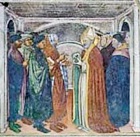
This cycle was fundamental for the development of Augustinian iconography, and many of the scenes also throw light on daily life in Gubbio in the early 15th century. The frescoes were restored in 1965.
Crucifix (16th century)
The painted (or repainted) crucifix that hangs above the high altar is tentatively attributed to Ventura Merlini (the son of the more famous Orlando Merlini).
Martyrdom of St Sebastian (ca. 1600)
This altarpiece in the 1st chapel on the right, which is attributed to Virgilio Nucci, was painted for the church of the Monastero di Santo Spirito. It was originally curved at the top but later transformed into its current rectangular format. It entered the civic collection in the 1920s and was transferred to Sant’ Agostino in 1975 because it was mistaken for a documented panel of the same subject from Sant’ Agostino that is actually lost.
Deposition (early 17th century)
This altarpiece is on the 2nd chapel on the right is attributed to Virgilio Nucci. The depicts St John the Evangelist and Joseph of Arimithea laying the body of Christ on a bier as the Virgin swoons into the arms of St Mary Magdalene. The crosses on which Christ and the two thieves had been crucified can be seen on Golgotha in the distance.
Madonna delle Grazie (ca. 1420)
An inscription to the right of the altar of the 3rd altar on the right records that its altarpiece includes a fresco that was detached from a column (probably the 3rd pilasters on the right) in 1647:
-
✴The detached fresco, which is attributed to Ottaviano Nelli or his workshop, depicts the Madonna and Child seated on the ground, with two musical angels to the sides and two other angels below presenting souls in Purgatory to them. A female saint, possibly St Martha, stands to the side.
-
✴The 17th century additions include:
-
•a dove representing the Holy Spirit, above; and
-
•two angels holding a scroll with the inscription “GRATIA MATER” below.
St Laurence (ca. 1665)
This small panel above the main altarpiece on the altar of the 3rd altar on the right is attributed to Francesco Allegrini.
St Ambrose baptizing St Augustine (1594)
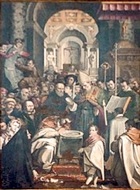
St Nicholas of Tolentino (17th century)
The altarpiece of the Cappella di San Nicolò da Tolentino (the 5th chapel on the right) depicts the Apotheosis of St Nicholas of Tolentino. It is surrounded by 12 small panels depicting scenes from his life [on the internal surfaces of the piers and arch of the frame ??]. These panels are attributed to Giovanni Battista Michelini, il Folignate.
The altarpiece can be raised mechanically to reveal a statue (18th century) of St Nicholas of Tolentino
SS Christopher, Ubaldus and Sebastian (15th century)
This detached and damaged fresco in the 6th chapel on the right, which was discovered in 1958, is attributed to Ottaviano Nelli and his workshop.
Madonna and Child with saints (early 17th century)
This altarpiece in the 7th chapel on the right is attributed to Virgilio Nucci. It depicts the Madonna and Child enthroned with SS Augustine and Francis. Below is a bust of the donor , who has a a noticeable scar on his forehead: this is probably Lorenzo Traversi, to whom the chapel belonged.
Assumption of the Virgin with saints (ca. 1591)
This altarpiece in the 6th chapel on the left depicts the Assumption of the Virgin with SS Augustine, Monica, Francis and Jerome. It was given by Virgilio Nucci to Teodora Paulozzi (the owner of the chapel) as part of the price of some property he had acquired from her in 1591.
Composite Altarpiece
This composite altarpiece is in the 5th chapel on the left.
-
✴The image at the centre employs the iconography of the Madonna del Soccorso, in which the Virgin saves a child from the Devil at the behest of his mother. The seven figures in the lower part of the central panel are clearly later additions. (They were probably members of the Members of the Biscaccianti family, who owned the chapel in the 17th century). An inscription recovered under these figures records that Fr. Silvestro da Città Sant’ Angelo commissioned it in 1485, during the tenure of Prior Angelo da Gubbio. This might be the image referred to in a document of 1632, which recorded a Mass celebrated at the Altare della SS Madonna del Soccorso in Sant’ Agostino to thank the Virgin for having saved Gubbio from a recent plague epidemic, after which an image of this iconography from Naples was taken in procession.
-
✴The central image is surrounded on three sides by small panels of Augustinian saints, below an image of God the Father. in the triangular pediment These panels and the over-painting of the lower part of the central panel are attributed to Pier Angelo Basili (died 1604).
-
✴The altarpiece slides to reveal a niche that contains an image of the Madonna della Cintura. An inscription behind this figure records that it was “remade” in 1865.
Madonna and Child with saints (1595)
This altarpiece is in the 4th chapel on the left. Its inscription records: the name of the lady who commissioned it, Vincenza Zanzi; the name of the artist, “G.B.” (Giovanni Maria Baldassini); and the date, 1595. It depicts the Madonna and Child enthroned, with two angels holding a crown above the head of the Madonna. The baby Jesus offers a wedding ring to St Catherine of Alexandria (in the so-called mystical marriage), while St John the Baptist draws the scene to the viewer’s attention. St Catherine is depicted with the wheel and palm of her martyrdom, and the fictive relief at the base of the throne depicts her disputation before the Emperor.
Crucifixion with saints (1609)
This late work by Felice Damiani in the 2nd chapel on the left is signed and dated by inscription. The artist actually died in 1608 (and was buried in Sant’ Agostino). The altarpiece was thus presumably completed by his workshop. It depicts SS Mary Magdalene, and Francis kneeling at the foot of the cross, flanked by the Virgin and SS Jerome, John the Evangelist and Antony Abbot.
Christ and the woman from Samaria (1580)
This altarpiece above the font (in the 1st chapel on the left) is signed by Virgilio Nucci and dated by inscription. A second inscription records the name of the commissioner, Angelo Mattioli.
Art from the Church
Virgin with SS Augustine and Monica (15th century)
This altarpiece in the Pinacoteca Civica depicts the Virgin, who stands on Christ’s sepulchre, with SS John the Baptist and Ubaldus. It is documented in the sacristy and probably came from the Cappella di Santa Maria Assunta.
Furniture of the High Altar
The gilded wooden tabernacle and altar screen were removed from the high altar and taken to Santa Maria Nuova in 1920.
Tabernacle (ca. 1577)
Bishop Mariano Savelli commissioned the gilding of this wooden tabernacle in 1577 and a will of 1583 provided for its ornamental housing (which suggests that it was finished by then). It is attributed to Faustino Maffei or (more recently) to Antonio Maffei. It was removed from the high altar and taken to Santa Maria Nuova in 1920.
Altar Screen (1640-5)
The Compagnia del SS Sacramento commissioned this screen in 1640 from Giovanni Francesco and Giacomo Casali, who were required to build it following a design by Michele Buti da Pisa. Giovanni Francesco subsequently withdrew from the contract, and Giacomo received payment for additional work on it in 1645. The structure contains a central niche that originally housed the tabernacle (above) and two smaller niches to the sides. These still contain their original statues, of St Augustine (on the left) and St William the Hermit.
Martyrdom of St Ursula (ca. 1655-7)
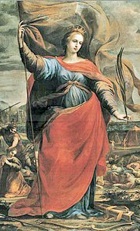
Read more:
F. Cece and E. Sannipoli, “La Chiesa e il Convento do Sant’ Agostino in Gubbio”, (2001) Perugia
Return to Monuments of Gubbio.
Return to Return to Walk II.

